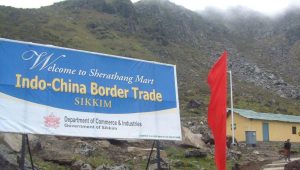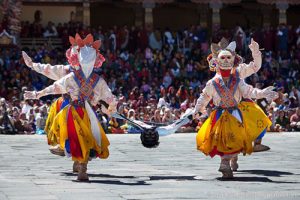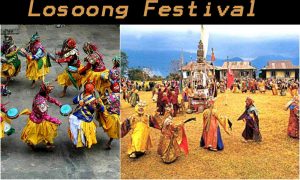Sikkim : Trade and Commerce
Sikkim is one of the fastest growing states in India. The state has favorable agro-climatic conditions, which support agriculture, horticulture and forestry. As per the state budget 2016-17, Sikkim got certified as first fully organic state in India by the Central Ministry of Agriculture and Farmers’ Welfare as well as other recognized agencies of the country.
Between 2004-05 and 2015-16, Gross State Domestic Product (GSDP) expanded at a compound annual growth rate (CAGR) of 19.44 per cent to US$ 2.75 billion whereas the Net State Domestic Product (NSDP) expanded at a CAGR of 19.11 per cent to US$ 2.33 billion.
The State Government has achieved remarkable progress in the core areas of agriculture, health, education and development in infrastructure. Today, Sikkim is the most talked-about state in the Country.
Sikkim has evolved as a progressive State with marked improvements in socio-economic indicators, despite facing the disadvantages of inadequate connectivity, high cost of infrastructure building and maintenance, difficulty in delivering services to dispersed populations in hilly areas.
People of Sikkim engage in different economic activities, prominent among which are Tourism, Industries, horticulture & agriculture etc. giving rise to a definite occupational structure. Major contributions to the economy are provided by sectors like Agriculture, Horticulture, Forest, Mining, Industries, Power, Tourism, Aqua Culture and Livestock etc.
Agricultural economy
The state’s economy is largely agrarian, based on the terraced farming of rice and the cultivation of crops such as maize, millet, wheat, oil seeds, pulses, spices, cereals barley, oranges, tea and cardamom.
Agriculture is vital to the progress of Sikkim as more than 64% of the population depends on it for their livelihoods. The Sikkim AGRISNET is an internet-based agriculture information centre to promote scientific agricultural methods and convert research into practice in the agricultural sector. Sikkim has a suitable climate for agricultural and horticultural products. It supports multiple crops; viz., rice, wheat, maize, millet, barley, urad, pea, soya bean, mustard and large cardamom. The surveyed arable land in Sikkim is 109,000 ha, of which only 9.5% is used, this provides a vast untapped potential for development. The state government is also laying emphasis on improving organic farming in the state.
Agriculture is the major economic activity and is practiced on terraced field that has been laboriously created from steep hillsides. There are in all 689 enterprises that have been identified, which are mostly concentrated in rural areas.
Sikkim is the largest producer of cardamom and also boasts to utilize largest area for its cultivation. Tea is exported to USSR & Germany. A coffee plantation has also been started at Majitar.
The economy broadly depends on the agriculture which provides livelihood to the majority of population in the state. However, it’s progress remained limited due to difficult topography and other natural barriers. As a result all head sectors related to agriculture emerged, government is doing its best to improve the situation.
Horticulture
Horticulture also contributes to the economy of Sikkim. Large Cardamom, ginger and turmeric are the principal crops while Mandarin orange, guava, mango, banana and so on are the principal fruits grown in the state. The department of Horticulture is deeply involved in motivating and providing technical guidance to local farmers. Sikkim is also a paradise for flowers. Gladioli, anthuriums, lilliums, primulas, rhododendrons, orchids as well as many other floral species thrive here. The state is home to an amazing 450 species of exotic orchids alone. There is immense potential for developing floriculture on a commercial basis here, and the department of Horticulture is making concerted efforts to turn this sector into an export-oriented industry.
Forest
Sikkim has rich bio diversity and thus provides economic activities. The total land area managed by and under administrative control of Forest Department is above 80% of the total geographical area of the state. The composition ranges from tropical Dry Deciduous Forests with Sal and its associates in the valleys of Teesta and Rangit to the Alpine Scrub and Grasslands in high altitudes. During the two last decades Forest Department has laid emphasis on development of fodder and fuel wood in the agriculture fallow lands of the villagers giving priority to plantation of broom grass for fodder and for economic up liftment of the villagers.
Aqua Culture
Pisiculture is an important area of economic activity particularly in the context of enabling the rural people. The state’s natural resources endowments with an extensive network of freshwater rivers, lakes and streams offers conditions which are conducive for development of inland fisheries where a variety of carps and trout’s can thrive. With a view to exploit these natural resources endowments.
Sericulture
Mulberry, muga, eri and oak-tussar are cultivated in Sikkim. The Sericulture Directorate is responsible for development of sericulture in Sikkim. The sericulture potentiality of Sikkim state has been explored jointly by the State Department and Central Silk Board, through launching a flagship programme titled Catalytic Development Programme. Over the years with consorted efforts from the both ends (state and central governments), considerable success have been achieved by the state sericulture industry in generating employment. Raw silk production in the state increased from 0.20 metric tonnes in 2013-14 to 6.0 metric tonnes in 2015-16.
Livestock
Animal Husbandry provides an additional source of income to the people. Animal husbandry form an extremely important element in the effort to bring about substantial improvements in living standards. The overall area available for agriculture operations is limited to about 15% of the geographical area of the state and with the increasing population, per capita land availability has been consistently declining, it is therefore, essential, that supplementary sources of income should be developed in order to provide not only the much needed support to the rural families but also to make available in increasing quantity, protein rich food items such as milk, egg, and meat. Adequate number of livestock like cattle, buffaloes, pigs, sheep’s, goats, yaks and few other are reared in Sikkim. Yaks are reared in north eastern ranges bordering Tibet, Bhutan and western region bordering Nepal.
Industries and Mining
The Commerce and Industries Department of Sikkim is involved in promoting trade and industry in Sikkim. The Sikkim Industrial Development & Investment Corporation Limited (SIDICO) is the state-level institution engaged in promoting, financing and developing the tiny and small scale industries (SSI) sector in the state.
Brewing, distilling, tanning and watch making are the main industries located in the southern regions of Sikkim. A small mining industry exists in the state, extracting minerals such as copper, dolomite, talc, graphite, quartzite, coal, zinc and lead. Sikkim has identified Rangpo-Gangtok, Melli-Jorethang, Jorethang-Rishi and Ranipool-Gangtok as industrial corridors with provision for giving land to investors on a lease basis.
The units that are engaged in the manufacturing sector are mainly dealing with pharmaceuticals, chemicals, liquors, foam mattresses, food products, iron rods, etc. Sikkim has identified agro-based industries, horticulture and floriculture, minor forest-based industries, animal husbandry and dairy products, tourism-related industries, IT including knowledge-based industries, precision oriented high value-low volume products, hydro-power, tea, education and hospitality as thrust sectors. The Information Technology (IT) Department, Government of Sikkim is in the process of setting up a state-of-the-art IT Park and National Institute of Electronics and Information Technology (NIELIT) at Pakyong.
Pharmaceuticals
Pharmaceutical is an emerging industry in Sikkim due to tax incentives offered by the state government as well as low manufacturing and labor costs. Sikkim is home to 14 major pharma companies, which have significant investments in the state. The North-East Industrial and Investment Promotion Policy, 2007 and the pollution free atmosphere are highly beneficial for pharma investments in Sikkim. Some of the policy incentives are: 100% excise duty exemption on finished products. 100% income tax exemption. 30% capital investment subsidy on investments in plant and machinery.
The policy of framework in regard to industrialization in Sikkim has to be formulated keeping in mind the particular factors endowments that the state has the limitations in regard to resources, particularly, minerals and industrial raw materials as well as man power. The state is not so rich in mineral resources and apart from the deposits of copper, lead and zinc, no other viable and exploitable mineral deposits have so far been discovered. While on the other hand the state enjoys a tranquil climate, a dust free atmosphere and peaceful industrial entrepreneurial talent, has also to be taken note of. In regard to industrial development, a number of small and medium units have been promoted in the state. For example, The Sikkim Time Corporation (SITCO) and Government Institute of Handicraft and Handlooms.
Mining
The state of Sikkim is endowed with rich geological resources. The department of mines and geology has been responsible for exploration and establishment of mineral resources, with the object of developing commercially exploitable mineral resources. Moderate to fair amount of success has been achieved during the investigation carried out by different agencies in certain sectors namely dolomite, coal, quartzite, graphite, lime stone, silliminite, talc, mineral water, thermal springs, building stone and materials for porcelain.
Tourism
Tourism provides the main thrust to the economy. With the tranquil climate, the natural beauty and the fine cultural heritage of Sikkim, the growth of tourism has immense possibilities. There are large number of places of tourist attraction particularly the snow clad mountains, the lakes and unspoiled forest areas and valleys of flowers. The advantage of having very fine monasteries in Sikkim can also be taken to attract Buddhist tourists from countries like Japan and the South Eastern countries.
Sikkim was the first to promote the concept of eco-tourism, village tourism and home stay tourism in the country. This essential concept promoting man-nature affinity has been recognized as a new model of tourism. Today, Sikkim is already on the national and international tourism map.
Sikkim has been featured and ranked 17th in the New York Times “52 best places to go in 2017”. Similarly, Sikkim has also been featured as the best destination to visit in the world in 2014.
The Year 2017 has been declared as the Year of Sustainable Tourism for Development, an area of development in which Sikkim has already made considerable strides with eco-friendly tourism and the development of innovative initiatives such as Chaar Dham and Tathagatha Tsal. Additionally, Gangtok City has been recognized as the safest tourist destination in the country.
Keeping nature at the backdrop, the State Government proposes to promote tourism mainly through nature based tourism. Few activities which are proposed include, Rock Art Sculpture, Folk Healing Center and Yoga Sthan. In the niche Tourism Sector, facilities such as golf courses, water sports etc, are being proposed.
A priority has been given to create mega projects, one example of which is the Sky Walk at Bhaleydunga. The Ropeway to Bhaleydunga, currently under progress is expected to be completed in 2 years time. Today, Sikkim having been featured in leading International Journals and magazines, has become one of the most sought after destinations and caters to all types of tourists. Film tourism is also catching up fast with the support of the government, as many recent film shoots by popular Bollywood artistes in the state takes place.
Through sustainable forest management practices and massive afforestation drives, about 72.60 lakh saplings have been planted till date under the State Government’s flagship programmes such as Smritivan, State Green Mission, Ten Minutes to Earth and Paryavaran Mahotsav. The forest and tree cover of the State has increased by about 4% over the last two decades from 43.95% to 47.80%. The State Government has also banned the use and sale of disposable Styrofoam products, prohibited the burning of tyres, agricultural waste, use of packaged drinking water bottles, bursting of crackers in Sikkim which are first such prohibitions imposed in the entire world.
The declaration of the Khangchendzonga National Park as UNESCO’s World Heritage Site on 17th July, 2016 at Istanbul, Turkey, is a testimony to the tireless efforts of the government. The Khangchendzonga National Park has also been declared as one of the 100 top Green Destinations of the world for the second consecutive time. In addition to this, the State Government is also proposing to develop a world class Biodiversity Park and Ecotourism Centre at Tendong, South Sikkim.
The State Government has now prioritized the construction of a Ropeway from Pelling to Sangacholing Monastery in West Sikkim connecting the landmark statue of Lord Chenrezig, that is near completion, to Pelling. This project along with the Statue of Lord Chenrezig would be a great value addition to tourism in boosting tourism footfall in the State. The boost in the tourist footfall is very encouraging as Sikkim hosted over 8 lakhs tourists in 2016 alone.
Major initiatives taken by the government to promote economy of the state
The state government launched Sikkim AGRISNET, an internet-based agriculture information centre, to promote scientific agricultural methods and convert research into practice in the agricultural sector.
The Government of Sikkim has placed information technology high on its agenda. The budget allocation for information and broadcasting is expected to be US$ 0.96 million during 2015-16.
Pharmaceutical is an emerging industry in Sikkim due to tax incentives offered by the state government as well as low manufacturing and labour costs. Sikkim is home to 14 major pharma companies, which have significant investments in the state. These include Cipla, Sun Pharma, ZydusCadila, Alembic, IPCA, Alkem Lab, Intas Pharma, Torrent Pharma and Unichem.
The Sikkim government has announced a technical collaboration with floriculturists from the Netherlands and Thailand to develop the state’s potential in floriculture and market cut flowers from the state globally.
The Department of Information Technology, Government of Sikkim is in the process of setting up an IT park and National Institute of Electronics and Information Technology (NIELIT) at Pakyong. The IT Park will have state-of-the-art facilities that will offer a plug and play environment and cater to the specific needs of the information technology and business process outsourcing (BPO) segments.
In order to give a boost to handloom and handicrafts sector, the Government of Sikkim has been making several efforts, which include providing training to upgrade the quality and designs of the products; bringing expertise and professionals for their marketing and supply, etc.
The Sikkim Government plans to set up Tea Development Corporation of Sikkim, which would be the nodal agency for developing the tea Industry in Sikkim. It would work to expand the Temi tea estates in the state and acquire new gardens either wholly or partially owned by the government.
The Sikkim Manipal University (SMU), a partnership between the Government of Sikkim and Manipal Education and Medical Group (MEMG), provides technical, healthcare and science education. It is rated as one of the top universities in the country.
The State Government is very concerned with the youth populace and therefore, has laid special emphasis to skill the youth and to make them employable and self-dependent so that they can lead a life of self-respect and confidence. A separate Department of Skill Development & Entrepreneurship and Capacity Building therefore has been setup with its network of the State Institute of Capacity Building, Livelihood schools, Industrial Training Institutes, Kaushal Kendras and Incubation Centres for skilling the youth. These initiatives aim at creating opportunities for self-employment, for industrial wage employment, and community based employment as Social Entrepreneurs.
Till December 2016, a total number of 10,151 trainees have been trained in sectors such as Beauty & Wellness, Tourism & Hospitality, Apparel, Homestay, Driver cum Tour Guide, Primary Teacher Training etc. An Atal incubation centre has been approved by the Ministry of Skill Development in Assam Lingzey. Two more incubation projects for the distillation of lemon grass oil has been set up in Kerabari, South Sikkim, and Timberbong, West Sikkim, under the Rastriya Krishi Vikas Yojana.



